Breast Cancer Prognosis Prediction and Immune Pathway Molecular Analysis Based on Mitochondria-Related Genes
- PMID: 35707265
- PMCID: PMC9174003
- DOI: 10.1155/2022/2249909
Breast Cancer Prognosis Prediction and Immune Pathway Molecular Analysis Based on Mitochondria-Related Genes
Abstract
Background: Mitochondria play an important role in breast cancer (BRCA). We aimed to build a prognostic model based on mitochondria-related genes.
Method: Univariate Cox regression analysis, random forest, and the LASSO method were performed in sequence on pretreated TCGA BRCA datasets to screen out genes from a Gene Set Enrichment Analysis, Gene Ontology: biological process gene set to build a prognosis risk score model. Survival analyses and ROC curves were performed to verify the model by using the GSE103091 dataset. The BRCA datasets were equally divided into high- and low-risk score groups. Comparisons between clinical features and immune infiltration related to different risk scores and gene mutation analysis and drug sensitivity prediction were performed for different groups.
Result: Four genes, MRPL36, FEZ1, BMF, and AFG1L, were screened to construct our risk score model in which the higher the risk score, the poorer the prognosis. Univariate and multivariate analyses showed that the risk score was significantly associated with age, M stage, and N stage. The gene mutation probability in the high-risk score group was significantly higher than that in the low-risk score group. Patients with higher risk scores were more likely to die. Drug sensitivity prediction in different groups indicated that PF-562271 and AS601245 might be new inhibitors of BRCA.
Conclusion: We developed a new workable risk score model based on mitochondria-related genes for BRCA prognosis and identified new targets and drugs for BRCA research.
Copyright © 2022 Weixu Luo et al.
Conflict of interest statement
The authors declare that there are no conflicts of interest regarding the publication of this paper.
Figures
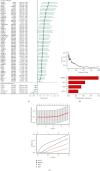

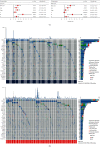
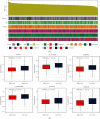
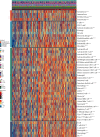
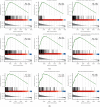
Similar articles
-
Construction of a novel mRNA-signature prediction model for prognosis of bladder cancer based on a statistical analysis.BMC Cancer. 2021 Jul 27;21(1):858. doi: 10.1186/s12885-021-08611-z. BMC Cancer. 2021. PMID: 34315402 Free PMC article.
-
Identification of the prognostic value of ferroptosis-related gene signature in breast cancer patients.BMC Cancer. 2021 May 31;21(1):645. doi: 10.1186/s12885-021-08341-2. BMC Cancer. 2021. PMID: 34059009 Free PMC article.
-
Predicting prognosis and clinical features of the tumor microenvironment based on ferroptosis score in patients with breast cancer.Sci Rep. 2022 Jun 23;12(1):10611. doi: 10.1038/s41598-022-14964-7. Sci Rep. 2022. PMID: 35739315 Free PMC article.
-
Construction and Validation of Angiogenesis-Related Prognostic Risk Signature to Facilitate Survival Prediction and Biomarker Excavation of Breast Cancer Patients.J Oncol. 2022 Apr 20;2022:1525245. doi: 10.1155/2022/1525245. eCollection 2022. J Oncol. 2022. PMID: 35498539 Free PMC article.
-
A Novel Signature Integrated of Immunoglobulin, Glycosylation and Anti-Viral Genes to Predict Prognosis for Breast Cancer.Front Genet. 2022 Apr 1;13:834731. doi: 10.3389/fgene.2022.834731. eCollection 2022. Front Genet. 2022. PMID: 35432482 Free PMC article.
Cited by
-
The exploration of mitochondrial-related features helps to reveal the prognosis and immunotherapy methods of colorectal cancer.Cancer Rep (Hoboken). 2024 Jan;7(1):e1914. doi: 10.1002/cnr2.1914. Epub 2023 Oct 30. Cancer Rep (Hoboken). 2024. PMID: 37903487 Free PMC article.
-
Integration of transcriptomics and machine learning for insights into breast cancer: exploring lipid metabolism and immune interactions.Front Immunol. 2024 Oct 25;15:1470167. doi: 10.3389/fimmu.2024.1470167. eCollection 2024. Front Immunol. 2024. PMID: 39524444 Free PMC article.
-
Constructing a mitochondrial-related genes model based on machine learning for predicting the prognosis and therapeutic effect in colorectal cancer.Discov Oncol. 2025 May 3;16(1):661. doi: 10.1007/s12672-025-02462-x. Discov Oncol. 2025. PMID: 40317411 Free PMC article.
-
Mitochondrial ribosomal proteins in metastasis and their potential use as prognostic and therapeutic targets.Cancer Metastasis Rev. 2024 Dec;43(4):1119-1135. doi: 10.1007/s10555-024-10216-4. Epub 2024 Oct 1. Cancer Metastasis Rev. 2024. PMID: 39354291 Free PMC article. Review.
-
Deciphering molecular landscape of breast cancer progression and insights from functional genomics and therapeutic explorations followed by in vitro validation.Sci Rep. 2024 Nov 20;14(1):28794. doi: 10.1038/s41598-024-80455-6. Sci Rep. 2024. PMID: 39567714 Free PMC article.
References
Publication types
MeSH terms
LinkOut - more resources
Full Text Sources
Medical

